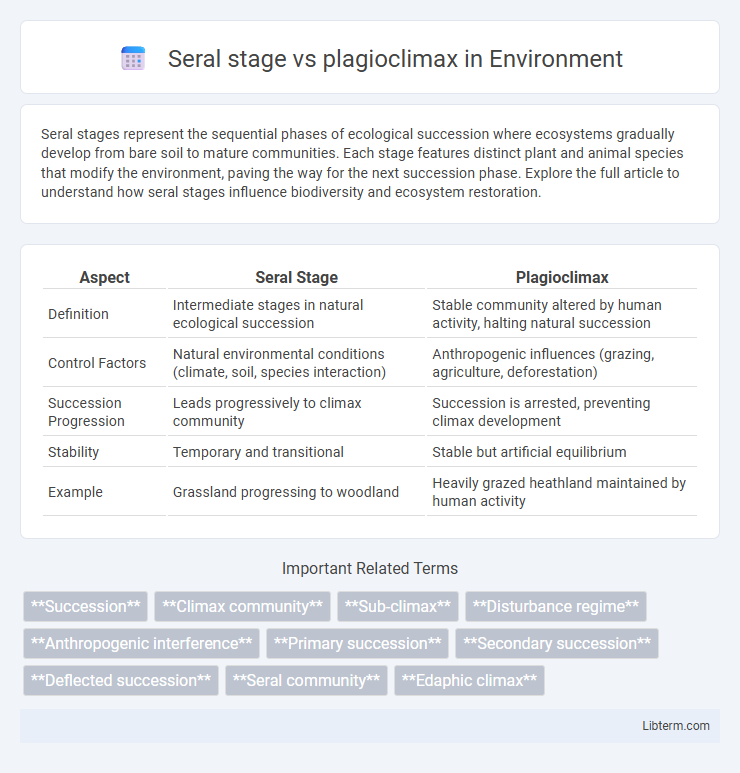Seral stages represent the sequential phases of ecological succession where ecosystems gradually develop from bare soil to mature communities. Each stage features distinct plant and animal species that modify the environment, paving the way for the next succession phase. Explore the full article to understand how seral stages influence biodiversity and ecosystem restoration.
Table of Comparison
| Aspect | Seral Stage | Plagioclimax |
|---|---|---|
| Definition | Intermediate stages in natural ecological succession | Stable community altered by human activity, halting natural succession |
| Control Factors | Natural environmental conditions (climate, soil, species interaction) | Anthropogenic influences (grazing, agriculture, deforestation) |
| Succession Progression | Leads progressively to climax community | Succession is arrested, preventing climax development |
| Stability | Temporary and transitional | Stable but artificial equilibrium |
| Example | Grassland progressing to woodland | Heavily grazed heathland maintained by human activity |
Introduction to Ecological Succession
Seral stages represent the intermediate phases in ecological succession where communities gradually change towards a stable climax ecosystem, characterized by species composition and structure adaptations. Plagioclimax occurs when human activities or environmental disturbances halt succession, maintaining an artificial or secondary stable community distinct from the natural climax. Understanding these stages is crucial for managing ecosystems and predicting vegetation dynamics over time.
Defining Seral Stages
Seral stages are distinct phases of ecological succession characterized by the development and establishment of specific plant and animal communities over time. These stages represent a sequence of biological changes leading to a stable climax community, often influenced by environmental factors such as soil quality, moisture, and disturbance frequency. Plagioclimax occurs when human activities or other disturbances arrest succession, maintaining a community in a seral stage rather than allowing progression to the natural climax.
Understanding Plagioclimax
Plagioclimax refers to a stable vegetation community resulting from human intervention that halts natural succession, preventing an ecosystem from reaching its climatic climax. Unlike seral stages, which represent transitional phases in ecological succession toward climax, plagioclimax areas maintain altered species composition due to activities like farming, grazing, or controlled burning. Understanding plagioclimax is essential for ecological restoration and management, as it highlights the long-term impact of human disturbances on ecosystem dynamics and biodiversity.
Natural Succession vs. Human Intervention
Seral stages represent the natural progression of ecological succession where ecosystems gradually develop through a series of intermediate communities leading to a climax stage. Plagioclimax occurs when human intervention, such as agriculture or deforestation, disrupts this natural succession, resulting in a stable but altered community that differs from the original climax vegetation. Understanding the distinction highlights how human activities can arrest or redirect ecological development, affecting biodiversity and ecosystem resilience.
Causes of Plagioclimax Communities
Plagioclimax communities develop primarily due to human activities such as agriculture, deforestation, and grazing, which disrupt natural succession processes. These disturbances prevent ecosystems from reaching their natural seral stages, resulting in artificially maintained or arrested vegetation states. Environmental modifications like fire regimes, soil compaction, and introduced species further stabilize plagioclimax conditions by inhibiting the progression to climax communities.
Characteristics of Seral Stage Ecosystems
Seral stage ecosystems exhibit dynamic succession marked by increasing biodiversity, structural complexity, and resource availability as they progress towards climax communities. They are characterized by pioneer species that modify the environment, facilitating the establishment of more competitive plants and animals. These stages display varying nutrient cycles and energy flows, reflecting ecological shifts critical for habitat development before plagioclimax stabilization.
Examples of Seral Stages in Nature
Seral stages represent intermediate phases in ecological succession, such as the growth of grasses after a forest fire or the colonization of bare soil by lichens and mosses in tundra regions. These stages gradually lead to a stable plagioclimax community, which often occurs due to human interference or natural disturbances preventing the climax state, like agricultural fields maintained as grasslands. Examples include secondary growth forests in abandoned farmlands and shrublands on previously logged hillsides, illustrating the dynamic nature of seral progression before reaching a plagioclimax.
Case Studies of Plagioclimax Habitats
Plagioclimax habitats result from human activities that prevent ecosystems from reaching their natural climax stage, often maintaining an altered seral stage. Case studies of plagioclimax environments, such as heathlands in Europe and grazing-influenced grasslands in Australia, demonstrate how continuous disturbance like mowing, grazing, or fire suppression sustains specific plant communities differing markedly from potential climax vegetation. These studies highlight the importance of understanding human impact on vegetation dynamics for effective habitat management and conservation strategies.
Ecological Implications and Management
Seral stages represent transitional communities during ecological succession, while plagioclimax indicates communities maintained by human activities or disturbances, altering natural succession. Recognizing plagioclimax helps in managing ecosystems to restore native biodiversity and ecological functions by mitigating anthropogenic impacts. Effective management integrates understanding these dynamics to balance conservation goals with sustainable land use practices.
Conclusion: Balancing Succession and Stability
Seral stages represent transitional phases in ecological succession leading toward a climax community, while plagioclimax describes a stable vegetation state maintained by external disturbances such as human activity. Balancing succession and stability involves recognizing the dynamic interplay between natural progression and anthropogenic factors that shape ecosystem structure. Effective ecosystem management requires integrating seral dynamics and the maintenance of plagioclimax conditions to promote biodiversity and resilience.
Seral stage Infographic

 libterm.com
libterm.com